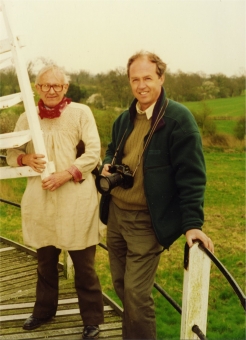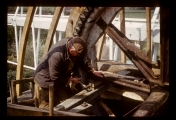Frank W. Gregory’s collection of mill-related archival material has been catalogued as part of a collaborative project, hosted by the Mills Archive in partnership with the Weald & Downland Museum, and made possible thanks to a grant of £49,900 from the Heritage Lottery Fund.

Frank William Gregory (1917-1998) was the Sussex authority on traditional mills, happily sharing his information and knowledge with everyone who had a similar interest. He painstakingly sketched, photographed and took notes at each mill he visited. Over 65 years, he built up an unrivalled record of windmlls and watermills in Sussex and beyond its borders, many of which have long since disappeared.
Supported by grant aid from the Heritage Lottery Fund and the Weald and Downland Open Air Museum, the Mills Archive’s has digitised and catalogued nearly 40,000 items from Frank’s collection, which he left to the Weald and Downland Open Air Museum at Singleton on his death in 1998.

Frank’s interest in mills began as a boy when he accompanied his father on car journeys around Sussex. Born and bred in Brighton, Frank developed a reputation as an avid photographer, researcher and collector of material relating to every type of mill. He became interested in the subject early enough in life to talk to the last generation of active Sussex millers and Sussex millwrights while this valuable seam of first-hand knowledge could still be mined. His enthusiasm for the repair of mills was infectious and directly contributed to the preservation of several Sussex examples such as Park Mill at Bateman’s, Nutley post mill, Polegate tower mill and Shipley smock mill.

Frank Gregory’s collection comprises large numbers of postcards, photographs, lantern slides and glass plate negatives, 35mm slides, measured drawings and field sketches, correspondence and ephemera, all relating to our heritage of traditional windmills and watermills in the UK and worldwide. Frank’s lifelong passion for mills has resulted in a unique legacy of information. Many of the photographic and written records that Frank made and the materials he collected relate to mills that have since been destroyed, increasing the historical value of these records.
The mammoth task of organising and identifying thousands of unidentified images has been undertaken by the Archive’s skilled volunteer team based in Reading and an expert panel formed by members of the Sussex Mills Group.

WORKING ON FRANK’S COLLECTION

FRANK’S MODELS OF MILL MACHINERY

SKETCHES OF SUSSEX WATERMILLS

FLOUR BAGS

WINDMILL RESTORATIONS – 1960S TO 1990S

EARLY VIEWS OF MILLS FROM GLASS NEGATIVES & SLIDES

MILLS THAT DIDN’T MAKE IT

MILLERS, MILLWRIGHTS & ENTHUSIASTS

